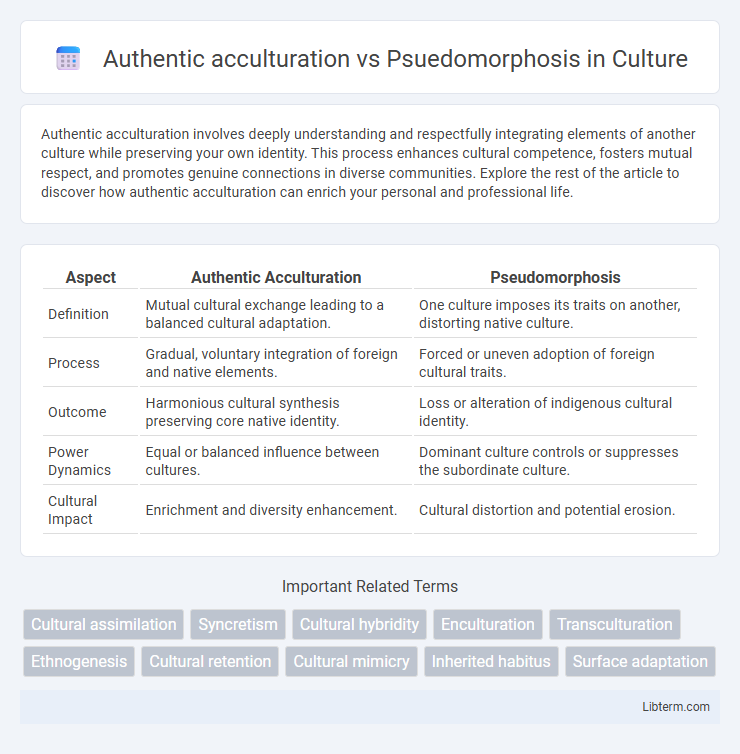Authentic acculturation involves deeply understanding and respectfully integrating elements of another culture while preserving your own identity. This process enhances cultural competence, fosters mutual respect, and promotes genuine connections in diverse communities. Explore the rest of the article to discover how authentic acculturation can enrich your personal and professional life.
Table of Comparison
| Aspect | Authentic Acculturation | Pseudomorphosis |
|---|---|---|
| Definition | Mutual cultural exchange leading to a balanced cultural adaptation. | One culture imposes its traits on another, distorting native culture. |
| Process | Gradual, voluntary integration of foreign and native elements. | Forced or uneven adoption of foreign cultural traits. |
| Outcome | Harmonious cultural synthesis preserving core native identity. | Loss or alteration of indigenous cultural identity. |
| Power Dynamics | Equal or balanced influence between cultures. | Dominant culture controls or suppresses the subordinate culture. |
| Cultural Impact | Enrichment and diversity enhancement. | Cultural distortion and potential erosion. |
Understanding Acculturation: Definitions and Concepts
Authentic acculturation involves the genuine exchange and adaptation of cultural traits between groups, leading to meaningful integration and mutual influence, whereas pseudomorphosis refers to the superficial adoption of a dominant culture's traits that mask the original cultural identity. Understanding acculturation requires distinguishing these processes, emphasizing the depth of cultural transformation rather than mere imitation. Key concepts include cultural continuity, adaptation mechanisms, and the authenticity of cultural integration.
Authentic Acculturation: Embracing Genuine Cultural Integration
Authentic acculturation involves the genuine integration of cultural values, customs, and social behaviors between distinct groups, fostering mutual respect and understanding. This process encourages the preservation of original cultural identities while adapting positively to new environmental influences, resulting in a harmonious cultural synthesis. Unlike pseudomorphosis, which imposes foreign elements superficially, authentic acculturation creates deep-rooted and sustainable intercultural relationships through reciprocal exchange and adaptation.
Psuedomorphosis: Masked Adaptation or Surface-Level Change
Pseudomorphosis in cultural contexts refers to surface-level change where a dominant culture imposes its traits on a subordinate one, masking the latter's authentic identity and inhibiting genuine acculturation. This phenomenon results in adaptation that preserves outdated or external forms without deep transformation, often leading to cultural stagnation rather than renewal. Unlike authentic acculturation, which integrates and evolves cultural elements meaningfully, pseudomorphosis enforces a superficial assimilation that fails to reflect true cultural synthesis.
Key Differences Between Authentic Acculturation and Psuedomorphosis
Authentic acculturation involves the genuine adaptation and integration of cultural traits from one society into another, resulting in a balanced fusion that respects both original and adopted elements. Pseudomorphosis refers to a superficial or forced cultural change where one culture is imposed over another, often leading to a distorted or incomplete transformation that suppresses the native cultural identity. The key difference lies in authenticity and mutual influence during the cultural exchange versus domination and loss of cultural integrity.
Historical Examples of Psuedomorphosis in Societies
Psuedomorphosis occurs when a dominant foreign culture imposes its forms on a native society, causing an incomplete or distorted cultural transformation, as seen in the Romanization of Gaul where Gallic traditions persisted beneath Roman administrative structures. Another example is the British colonial impact on India, where Western political systems and education partially overlaid but did not fully replace indigenous social and cultural frameworks. These historical instances highlight how psuedomorphosis results in hybrid societies struggling between imposed external influences and traditional cultural identities.
Factors Influencing Authentic Cultural Adaptation
Authentic acculturation occurs when a culture adapts by integrating foreign elements while maintaining its core identity, influenced by factors such as openness to change, social cohesion, and historical resilience. Psuedomorphosis describes a culture superficially adopting external traits without deep integration, often due to external domination or abrupt cultural imposition. Key influences on authentic cultural adaptation include intercultural dialogue, selective assimilation, and internal cultural reinforcement mechanisms.
The Psychological Impact of Authentic Acculturation vs Psuedomorphosis
Authentic acculturation fosters psychological resilience by allowing individuals to integrate new cultural elements while preserving core identity, leading to enhanced self-esteem and cultural coherence. In contrast, pseudomorphosis often triggers identity confusion and psychological distress as individuals are forced to conform to external cultural impositions without genuine internalization. Empirical studies highlight that authentic acculturation promotes mental well-being, whereas pseudomorphosis is linked to increased anxiety and a diminished sense of belonging.
Social Consequences of Surface-Level Cultural Imitation
Surface-level cultural imitation in pseudomorphosis often leads to social alienation and identity conflicts as individuals or groups struggle to reconcile imposed foreign practices with indigenous traditions. Authentic acculturation fosters meaningful integration by blending cultural elements in ways that promote social cohesion and mutual respect. The social consequences of pseudomorphosis include weakened community bonds and loss of cultural heritage, undermining long-term social stability.
Strategies to Promote Genuine Acculturation in Multicultural Communities
Strategies to promote genuine acculturation in multicultural communities emphasize mutual cultural exchange, respect for original traditions, and inclusive dialogue to foster understanding between groups. Implementing community programs that encourage shared experiences, bilingual education, and intercultural communication reduces the risk of pseudomorphosis, where one culture superficially adapts to another without true integration. Policy frameworks supporting equitable participation in social, economic, and political spheres ensure authentic cultural blending rather than forced assimilation.
Future Challenges: Navigating Authenticity in a Globalized World
Authentic acculturation promotes genuine cultural integration by preserving core traditions while adapting to new influences, ensuring sustainable identity continuity in a globalized world. Pseudomorphosis often results in superficial cultural changes imposed by dominant societies, leading to loss of indigenous values and social fragmentation. Future challenges revolve around fostering intercultural dialogue that respects diversity, combats cultural homogenization, and supports adaptive yet authentic cultural evolution.
Authentic acculturation Infographic

 libterm.com
libterm.com